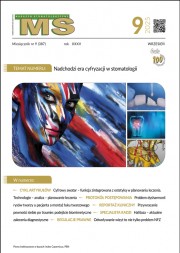Dostęp do tego artykułu jest płatny.
Zapraszamy do zakupu!
Po dokonaniu zakupu artykuł w postaci pliku PDF prześlemy bezpośrednio pod twój adres e-mail.
ARTYKUŁ ORYGINALNY
Ocena wiedzy lekarzy dentystów na temat szynowania zębów po urazie
Assessment of dentists knowledge about splinting teeth after trauma
Hanna Sobczak-Zagalska
Streszczenie
Szyny stosowane są w leczeniu urazów, którym towarzyszy uszkodzenie więzadeł ozębnej. Różnorodność szyn urazowych pozwala dentyście dobrać odpowiedni materiał, który spełnia wymagania danej sytuacji klinicznej i pacjenta. Celem pracy jest ocena wiedzy lekarzy dentystów na temat szynowania zębów po urazach. Badanie miało charakter ankietowy. Wzięło w nim udział 264 lekarzy dentystów. Wynik uzyskane z formularza online poddano analizie statystycznej. Z badań wynika, że wiedza lekarzy dentystów na temat stabilizacji zębów po urazach jest niewystarczająca. Wśród lekarzy dentystów stomatolodzy dziecięcy to specjaliści, których wiedza na temat stabilizacji pourazowo uszkodzonych zębów jest znacząco wyższa i ta grupa lekarzy wydaje się odpowiednio przygotowana do leczenia pacjentów z urazami zębów.
Abstract
Dental trauma splints are used to treat teeth injuries involving periodontal damage. The wide variety of trauma splits allows the dentist to choose the material that meets the requirements of a clinical situations and an individual patient. The aim of the study was the assessment of polish dentists’ knowledge about splinting teeth after trauma. A questionnaire survey was conducted. 264 dentists took part in the study. The result obtained from the online form was statistically analyzed. Research shows that the dentists’ knowledge about the stabilisation of teeth after injuries is insufficient. Among dentists, pediatric dentists are specialists whose knowledge of the stabilisation of injured teeth is signifi cantly higher, and this group of professionalists seems to be adequately prepared to treat patients with dental trauma.
Hasła indeksowe: szynowanie, urazy zębów
Key words: splinting, dental trauma
Piśmiennictwo
- Kahler B, Hu JY, Marriot-Smith C i wsp. Splinting of teeth following trauma. A review and a new splinting recommendation. Aust Dent J. 2016; 61 Suppl 1: 59-73.
- Berthold C, Thaler A, Petschelt A. Rigidity of commonly used dental trauma splints. Dent Traumatol. 2009; 25(3): 248-255.
- Kwan SC, Johnson JD, Cohenca N. The effect of splint material and thickness on tooth mobility after extraction and replantation using a human cadaveric model. Dent Traumatol. 2012; 28(4): 277-281.
- Ben Hassan MW, Andersson L, Lucas PW. Stiffness characteristics of splints for fixation of traumatized teeth. Dent Traumatol. 2016; 32(2): 140-145.
- Franz F, Potapov S, Petschelt A i wsp. Influence of adhesive point dimension and splint type on splint rigidity – evaluation by the dynamic Periotest method. Dent Traumatol. 2013; 29(3): 203-211.
- Berthold C, Auer FJ, Potapov S i wsp. Influence of wire extension and type on splint rigidity – evaluation by a dynamic and a static measuring method. Dent Traumatol. 2011; 27(6): 422-431.
- Bourguignon C, Cohenca N, Lauridsen E i wsp. International Association of Dental Traumatology guidelines for the management of traumatic dental injuries. 1. Fractures and luxations. Dent Traumatol. 2020; 36(4): 314-330.
- Levin L, Day PF, Hicks L i wsp. International Association of Dental Traumatology guidelines for the management of traumatic dental injuries. General introduction. Dent Traumatol. 2020; 36(4): 309-313.
- Sobczak M. Ocena wiedzy lekarzy dentystów na temat badania klinicznego i radiologicznego pacjentów podczas wizyty bezpośrednio po urazie. Badania ankietowe. Pol Stom Dziec. 2019; 4(1): 6-14.
- Baginska J, Wilczynska-Borawska M. Continuing dental education in the treatment of dental avulsion. Polish dentists’ knowledge of the current IADT guidelines. Eur J Dent Educ. 2013; 17(1): e88-e92.
- Buldur B, Kapdan A. Factors associated with knowledge and attitude of management of traumatic dental injuries. A cross-sectional study among Turkish dentists. Pesqui Bras Odontopediatria Clín Integr. 2018; 18(1): 3948.
- Krastl G, Filippi A, Weiger R. German general dentists’ knowledge of dental trauma. Dent Traumatol. 2009; 25(1): 88-91.
- von Arx T, Filippi A, Buser D. Splinting of traumatized teeth with a new device: TTS (Titanium Trauma Splint). Dent Traumatol. 2001; 17(4): 180-184.
- Sobczak‐Zagalska H, Emerich K. Assessment of a power chain as a new dental trauma splint and its comparison with two commonly used splinting materials. Appl Sci. 2020; 10(23): 8398.
- Zafar S, Peters CI. Dental trauma simulation training using four splinting models. A cross sectional study. Dent Traumatol. 2022; 38(6):519-525.














